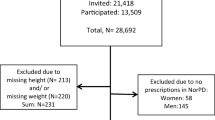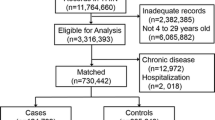Abstract
The few prospective studies examining the relation between proton pump inhibitor (PPI) use and risk of vertebral fracture (VF) suggest a higher risk, but the magnitude of the association has been inconsistent. Moreover, no prospective studies have examined the association between substantially longer duration of PPI use and VF risk. Our objective was to determine the association between PPI use, H2RA use, and incident clinical VF in women. We conducted a prospective study in 55,545 women participating in the Nurses’ Health Study. PPI and H2RA use was assessed by questionnaire every 4 years. Self-reports of VF were confirmed by medical record. Our analysis included 547 incident VF cases (2002–2014). The multivariate adjusted relative risk (MVRR) of VF for women taking PPIs was 1.29 (95% CI 1.04–1.59) compared with non-users. Longer duration of PPI use was associated with higher VF risk (MVRR 1.16 [0.90–1.49] for < 4 years; 1.27 [0.93–1.73] for 4–7.9 years; 1.64 [1.02–2.64] for ≥ 8 years; ptrend = 0.01). The MVRR of VF for women taking H2RAs was 1.22 (0.90–1.67) compared with non-users. Longer duration of H2RA use was not associated with VF risk (MVRR 1.16 [0.88–1.53] for < 4 years; 0.98 [0.60–1.59] for ≥ 4 years; ptrend = 0.72). PPI use is independently associated with a modestly higher risk of VF and the risk increases with longer duration of use. There was no statistically significant association between H2RA use and VF risk. Our findings add to the growing evidence suggesting caution with PPI use, particularly with longer duration of use.
Similar content being viewed by others
References
Menees SB, Guentner A, Chey SW, Saad R, Chey WD (2015) How do us gastroenterologists use over-the-counter and prescription medications in patients with gastroesophageal reflux and chronic constipation? Am J Gastroenterol 110:1516–1525
Qato DM, Wilder J, Schumm LP, Gillet V, Alexander GC (2016) Changes in prescription and over-the-counter medication and dietary supplement use among older adults in the United States, 2005 vs 2011. JAMA Intern Med 176:473–482
Riggs BL, Melton LJ 3rd (1995) The worldwide problem of osteoporosis: insights afforded by epidemiology. Bone 17:505S-511S
Nevitt MC, Ettinger B, Black DM, Stone K, Jamal SA, Ensrud K, Segal M, Genant HK, Cummings SR (1998) The association of radiographically detected vertebral fractures with back pain and function: a prospective study. Ann Intern Med 128:793–800
Barrett-Connor E (1995) The economic and human costs of osteoporotic fracture. Am J Med 98:3S–8S
Kado DM, Browner WS, Palermo L, Nevitt MC, Genant HK, Cummings SR (1999) Vertebral fractures and mortality in older women: a prospective study. Study of Osteoporotic Fractures Research Group. Arch Intern Med 159:1215–1220
Melton LJ 3rd (1997) Epidemiology of spinal osteoporosis. Spine 22:2S–11S
Melton LJ 3rd, Kan SH, Frye MA, Wahner HW, O’Fallon WM, Riggs BL (1989) Epidemiology of vertebral fractures in women. Am J Epidemiol 129:1000–1011
Amin S, Achenbach SJ, Atkinson EJ, Khosla S, Melton LJ 3rd (2014) Trends in fracture incidence: a population-based study over 20 years. J Bone Miner Res 29:581–589
Stein EM, Liu XS, Nickolas TL, Cohen A, McMahon DJ, Zhou B, Zhang C, Kamanda-Kosseh M, Cosman F, Nieves J, Guo XE, Shane E (2012) Microarchitectural abnormalities are more severe in postmenopausal women with vertebral compared to nonvertebral fractures. J Clin Endocrinol Metab 97:E1918–E1926
Genant HK, Delmas PD, Chen P, Jiang Y, Eriksen EF, Dalsky GP, Marcus R, San Martin J (2007) Severity of vertebral fracture reflects deterioration of bone microarchitecture. Osteoporos Int 18:69–76
Yeni YN, Zinno MJ, Yerramshetty JS, Zauel R, Fyhrie DP (2011) Variability of trabecular microstructure is age-, gender-, race- and anatomic site-dependent and affects stiffness and stress distribution properties of human vertebral cancellous bone. Bone 49:886–894
Christiansen BA, Bouxsein ML (2010) Biomechanics of vertebral fractures and the vertebral fracture cascade. Curr Osteoporos Rep 8:198–204
Myers ER, Wilson SE (1997) Biomechanics of osteoporosis and vertebral fracture. Spine 22:25S–31S
Duan Y, Seeman E, Turner CH (2001) The biomechanical basis of vertebral body fragility in men and women. J Bone Miner Res 16:2276–2283
Yu EW, Bauer SR, Bain PA, Bauer DC (2011) Proton pump inhibitors and risk of fractures: a meta-analysis of 11 international studies. Am J Med 124:519–526
Zhou B, Huang Y, Li H, Sun W, Liu J (2016) Proton-pump inhibitors and risk of fractures: an update meta-analysis. Osteoporos Int 27:339–347
Khalili H, Huang ES, Jacobson BC, Camargo CA Jr, Feskanich D, Chan AT (2012) Use of proton pump inhibitors and risk of hip fracture in relation to dietary and lifestyle factors: a prospective cohort study. BMJ 344:e372
Yu EW, Blackwell T, Ensrud KE, Hillier TA, Lane NE, Orwoll E, Bauer DC (2008) Acid-suppressive medications and risk of bone loss and fracture in older adults. Calcif Tissue Int 83:251–259
Fraser LA, Leslie WD, Targownik LE, Papaioannou A, Adachi JD, CaMos Research G (2013) The effect of proton pump inhibitors on fracture risk: report from the Canadian Multicenter Osteoporosis Study. Osteoporos Int 24:1161–1168
Yang YX, Lewis JD, Epstein S, Metz DC (2006) Long-term proton pump inhibitor therapy and risk of hip fracture. JAMA 296:2947–2953
Vestergaard P, Rejnmark L, Mosekilde L (2006) Proton pump inhibitors, histamine H2 receptor antagonists, and other antacid medications and the risk of fracture. Calcif Tissue Int 79:76–83
Kwok CS, Yeong JK, Loke YK (2011) Meta-analysis: risk of fractures with acid-suppressing medication. Bone 48:768–776
Targownik LE, Lix LM, Metge CJ, Prior HJ, Leung S, Leslie WD (2008) Use of proton pump inhibitors and risk of osteoporosis-related fractures. CMAJ 179:319–326
Ngamruengphong S, Leontiadis GI, Radhi S, Dentino A, Nugent K (2011) Proton pump inhibitors and risk of fracture: a systematic review and meta-analysis of observational studies. Am J Gastroenterol 106:1209–1218
Kaye JA, Jick H (2008) Proton pump inhibitor use and risk of hip fractures in patients without major risk factors. Pharmacotherapy 28:951–959
Gray SL, LaCroix AZ, Larson J, Robbins J, Cauley JA, Manson JE, Chen Z (2010) Proton pump inhibitor use, hip fracture, and change in bone mineral density in postmenopausal women: results from the Women’s Health Initiative. Arch Intern Med 170:765–771
Roux C, Briot K, Gossec L, Kolta S, Blenk T, Felsenberg D, Reid D, Eastell R, Glüer C (2009) Increase in vertebral fracture risk in postmenopausal women using omeprazole. Calcif Tissue Int 84:13–19
Ding J, Heller DA, Ahern FM, Brown TV (2014) The relationship between proton pump inhibitor adherence and fracture risk in the elderly. Calcif Tissue Int 94:597–607
O’Connell MB, Madden DM, Murray AM, Heaney RP, Kerzner LJ (2005) Effects of proton pump inhibitors on calcium carbonate absorption in women: a randomized crossover trial. Am J Med 118:778–781
Recker RR (1985) Calcium absorption and achlorhydria. N Engl J Med 313:70–73
Joo MK, Park JJ, Lee BJ, Kim JH, Yeon JE, Kim JS, Byun KS, Bak YT (2013) The effect of a proton pump inhibitor on bone metabolism in ovariectomized rats. Mol Med Rep 7:1267–1272
Mizunashi K, Furukawa Y, Katano K, Abe K (1993) Effect of omeprazole, an inhibitor of H+,K(+)-ATPase, on bone resorption in humans. Calcif Tissue Int 53:21–25
Tuukkanen J, Vaananen HK (1986) Omeprazole, a specific inhibitor of H+-K+-ATPase, inhibits bone resorption in vitro. Calcif Tissue Int 38:123–125
Gagnemo-Persson R, Samuelsson A, Hakanson R, Persson P (1997) Chicken parathyroid hormone gene expression in response to gastrin, omeprazole, ergocalciferol, and restricted food intake. Calcif Tissue Int 61:210–215
Rimm E, Stampfer M, Colditz GA, Chute C, Litin L, Willett W (1990) Validity of self-reported waist and hip circumference in men and women. Epidemiology 1:466–473
Wolf A, Hunter D, Colditz G, Manson J, Stampfer M, Corsano K, Rosner B, Kriska A, Willett W (1994) Reproducibility and validity of a self-administered physical activity questionnaire. Int J Epidemiol 23:991–999
Colditz GA, Martin P, Stampfer MJ, Willett WC, Sampson L, Rosner B, Hennekens CH, Speizer FE (1986) Validation of questionnaire information on risk factors and disease outcomes in a prospective cohort study of women. Am J Epidemiol 123:894–900
Manson JE, Colditz GA, Stampfer MJ, Willett WC, Krolewski AS, Rosner B, Arky RA, Speizer FE, Hennekens CH (1991) A prospective study of maturity-onset diabetes mellitus and risk of coronary heart disease and stroke in women. Arch Intern Med 151:1141–1147
Willett W, Sampson L, Stampfer M, Rosner B, Bain C, Witschi J, Hennekens C, Speizer F (1985) Reproducibility and validity of a semiquantitative food frequency questionnaire. Am J Epidemiol 122:51–65
Yuan C, Spiegelman D, Rimm EB, Rosner BA, Stampfer MJ, Barnett JB, Chavarro JE, Subar AF, Sampson LK, Willett WC (2017) Validity of a dietary questionnaire assessed by comparison with multiple weighed dietary records or 24-hour recalls. Am J Epidemiol 185:570–584
Freedberg DE, Kim LS, Yang YX (2017) The risks and benefits of long-term use of proton pump inhibitors: expert review and best practice advice from the american gastroenterological association. Gastroenterology 152:706–715
Solomon DH, Diem SJ, Ruppert K, Lian YJ, Liu CC, Wohlfart A, Greendale GA, Finkelstein JS (2015) Bone mineral density changes among women initiating proton pump inhibitors or H2 receptor antagonists: a SWAN cohort study. J Bone Miner Res 30:232–239
Targownik LE, Lix LM, Leung S, Leslie WD (2010) Proton-pump inhibitor use is not associated with osteoporosis or accelerated bone mineral density loss. Gastroenterology 138:896–904
Targownik LE, Leslie WD, Davison KS, Goltzman D, Jamal SA, Kreiger N, Josse RG, Kaiser SM, Kovacs CS, Prior JC, Zhou W, CaMos Research G (2012) The relationship between proton pump inhibitor use and longitudinal change in bone mineral density: a population-based study [corrected] from the Canadian Multicentre Osteoporosis Study (CaMos). Am J Gastroenterol 107:1361–1369
Acknowledgements
We are indebted to the participants in the Nurses’ Health Study for their continuing cooperation.
Funding
This research was supported by the National Institutes of Health grants DK100447, DK091417, and CA186107.
Author information
Authors and Affiliations
Contributions
All authors have contributed significantly to the manuscript. Study design: JMP, GCC. Acquisition and analysis of data: JMP. Interpretation of data: All authors. Drafting of the manuscript: JMP, GCC. Critical revision of the manuscript for important intellectual content: All authors. JMP takes responsibility for the integrity of the data and the accuracy of the data analysis.
Corresponding author
Ethics declarations
Conflict of interest
Julie M. Paik, Harold N. Rosen, Catherine M. Gordon and Gary C. Curhan state that they have no conflicts of interest.
Human and Animal Rights and Informed Consent
The study protocol was approved by the Brigham and Women’s Hospital Institutional Review Board.
Rights and permissions
About this article
Cite this article
Paik, J.M., Rosen, H.N., Gordon, C.M. et al. Proton Pump Inhibitor Use, H2-Receptor Antagonist Use, and Risk of Incident Clinical Vertebral Fracture in Women. Calcif Tissue Int 103, 380–387 (2018). https://doi.org/10.1007/s00223-018-0432-2
Received:
Accepted:
Published:
Issue Date:
DOI: https://doi.org/10.1007/s00223-018-0432-2




